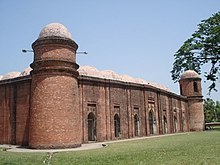
Sixty Dome Mosque in Mosque city of Bagerhat was built in the 15th century and is the largest historical mosque in Bangladesh, as well as a World Heritage site.
Shamsuddin Iliyas Shah founded an independent dynasty that lasted from 1342-1487. The dynasty successfully repulsed attempts by Delhi to conquer them. They continued to reel in the territory of modern-day Bengal, reaching to Khulna in the south and Sylhet in the east. The sultans advanced civic institutions and became more responsive and "native" in their outlook and cut loose from Delhi. Considerable architectural projects were completed including the massive Adina Mosque and the Darasbari Mosque which still stands in Bangladesh near the border. The Sultans of Bengal were patrons of Bengali literature and began a process in which Bengali culture and identity would flourish. The Ilyas Shahi Dynasty was interrupted by an uprising by the Hindus under Raja Ganesha. However the Ilyas Shahi dynasty was restored by Nasiruddin Mahmud Shah. The dynasty was finally overthrown by the Habshi (Abyssinian) slaves of the sultanate.
Bangladesh became one of the large nation states in 1971 when it seceded from Pakistan. Prior to the creation of Pakistan in 1947, modern-day Bangladesh was part of ancient, classical, medieval and colonial India.
Since independence, the government has experienced periods of democratic and military rule. The founding leader of the country and its first president was Sheikh Mujibur Rahman. His daughter Sheikh Hasina Wazed is currently the prime minister, as leader of the Awami League. The opposition Bangladesh Nationalist Party is led by Begum Khaleda Zia, who is the widow of the revered freedom fighter and former president Ziaur Rahman.
Pre-historic Bengal
Stone tools provide the earliest evidence of human settlements. Prehistoric stone implements have been discovered in various parts of West Bengal in the districts of Midnapur, Bankura and Burdwan. But it is difficult to determine, even approximately, the time when people using them first settled in Bengal. It might have taken place ten thousand years (or even more) ago. The original settlers spoke non-Aryan languages—they may have spoken Austric or Austro-Asiatic languages like the languages of the present-day Kola, Bhil, Santal, Shabara and Pulinda peoples. At a subsequent age, peoples speaking languages from two other language families—Dravidian and Tibeto-Burman—seem to have settled in Bengal. Archaeological discoveries during the 1960s furnished evidence of a degree of civilisation in certain parts of Bengal as far back as the beginning of the first millennium BC, perhaps even earlier. The discoveries at Pandu Rajar Dhibi in the valley of the Ajay River (near Bolpur) in Burdwan district and in several other sites on the Ajay, Kunar and Kopai Rivers have thrown fresh light on Bengal's prehistory. Pandu Rajar Dhibi represents the ruins of a trading township, which carried on trade not only with the interior regions of India, but also—possibly indirectly—with the countries of the Mediterranean.
Bengal in mythology
Some references indicate that the early people in Bengal were different in ethnicity and culture from the Vedic beyond the boundary of Aryandom and who were classed as 'Dasyus'. The Bhagavata Purana classes them as sinful people while Dharmasutra of Bodhayana prescribes expiatory rites after a journey among the Pundras and Vangas. Mahabharata speaks of Paundraka Vasudeva who was lord of the Pundrasand who allied himself with Jarasandha against Krishna. Mahabharata also speaks of Bengali kings called Chitrasena and Sanudrasena who were defeated by Bhima, Kalidas mentions Raghu defeated a coalition of Vanga kings who were defeated by Raghu and Raghu established a victory column in the Gangetic delta.
Proto-History

Mahasthangarh is the oldest archaeological site in Bangladesh. It dates back to 700 BCE and was the ancient capital of the Pundra Kingdom.
Hindu scriptures such as the Mahabharata say that Bangladesh was divided among various tribes or kingdoms, including the Nishadas and kingdoms known as the Janapadas: Vanga (southern Bengal), Pundra (northern Bengal), and Suhma (western Bengal) according to their respective totems. These Hindu sources, written by Indo-Aryans in what is now Punjab and Uttar Pradesh, say that the peoples of Bangladesh were not Indo-Aryans. However, Jain scriptures identify Vanga and Anga in Bangladesh as Indo-Aryan. While western Bangladesh, as part of Magadha, became part of the Indo-Aryan civilization by the 7th century BCE, the Nanda Dynasty was the first historical state to unify all of Bangladesh under Indo-Aryan rule.
Overseas Colonization
The Vanga Kingdom was a powerful seafaring nation of Ancient India. They had overseas trade relations with Java, Sumatra and Siam (modern day Thailand). According to Mahavamsa, the Vanga prince Vijaya Singha conquered Lanka (modern day Sri Lanka) in 544 BC and gave the name "Sinhala" to the country. Bengali people migrated to the Maritime Southeast Asia and Siam (in modern Thailand), establishing their own colonies there.







